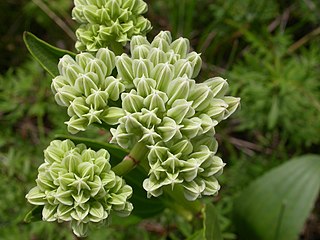
John Torrey was an American botanist, chemist, and physician. Throughout much of his career, he was a teacher of chemistry, often at multiple universities, while he also pursued botanical work, focusing on the flora of North America. His most renowned works include studies of the New York flora, the Mexican Boundary, the Pacific railroad surveys, and the uncompleted Flora of North America.

Coreopsis is a genus of flowering plants in the family Asteraceae. Common names include calliopsis and tickseed, a name shared with various other plants.

Senecioneae is the largest tribe of the Asteraceae, or the sunflower family, comprising about 150 genera and 3,000 species. Almost one-third of the species in this tribe are placed in the genus Senecio. Its members exhibit probably the widest possible range of form to be found in the entire plant kingdom, and include annuals, minute creeping alpines, herbaceous and evergreen perennials, shrubs, climbers, succulents, trees, and semi-aquatic plants.

Helianthus is a genus comprising about 70 species of annual and perennial flowering plants in the daisy family Asteraceae commonly known as sunflowers. Except for three South American species, the species of Helianthus are native to North America and Central America. The best-known species is the common sunflower, whose round flower heads in combination with the ligules look like the Sun. This and other species, notably Jerusalem artichoke, are cultivated in temperate regions and some tropical regions as food crops for humans, cattle, and poultry, and as ornamental plants. The species H. annuus typically grows during the summer and into early fall, with the peak growth season being mid-summer.

Lespedeza is a genus of some 40 species of flowering plants in the pea family (Fabaceae), commonly known as bush clovers or Japanese clovers (hagi). The genus is native to warm temperate to subtropical regions of eastern North America, eastern and southern Asia and Australasia.

Pseudemys is a genus of large, herbivorous, freshwater turtles of the eastern United States and adjacent northeast Mexico. They are often referred to as cooters, which stems from kuta, the word for turtle in the Bambara and Malinké languages, brought to America by enslaved people from Africa.

Rudbeckia is a plant genus in the Asteraceae or composite family. Rudbeckia flowers feature a prominent, raised central disc in black, brown shades of green, and in-between tones, giving rise to their familiar common names of coneflowers and black-eyed-susans. All are native to North America, and many species are cultivated in gardens for their showy yellow or gold flower heads that bloom in mid to late summer.

Arnoglossum is a North American genus of plants in the family Asteraceae, described as a genus in 1817. They have the common name Indian plantain because they resemble the unrelated common plantain.

Houstonia (bluet) is a genus of plants in the family Rubiaceae. Many species were formerly classified, along with other genera since segregated elsewhere, in a more inclusive genus Hedyotis.

Pithecellobium is a genus of flowering plants in the family Fabaceae. The generic name is derived from the Greek words πιθηκος (pithekos), meaning "ape" or "monkey," and ελλοβιον (ellobion), meaning "earring," which refers to the coiled shape of the fruit pods. Plants of the genus are known generally as blackbeads.

Heliotropium curassavicum, commonly called salt heliotrope, a species of flowering plant in the borage family (Boraginaceae). It is native to much of the Americas, from Canada to Argentina, including the West Indies and Hawaii. It can be found as an introduced, and sometimes invasive, species in Africa, Asia, Australia, and Europe. It thrives in salty soils, such as beach sand, alkali flats, and salt marshes. It is often found in disturbed coastal sites.

The genus Cacalia L. is a nomen rejiciendum under the International Code of Nomenclature for algae, fungi, and plants. The type species C. alpina L. has been transferred to Adenostyles alpina (L.) Bluff & Fingerh., and the former species of Cacalia now reside in a few different genera.

Arnoglossum plantagineum also known as tuberous Indian-plantain, groovestem Indian plantain or Prairie Indian plantain, is a North American species of Arnoglossum in the sunflower family. The Latin specific epithet plantagineum refers to the leaves of the plant which are similar to those of a plantain.
Sclerolepis is an aquatic plant native to the eastern United States. It has only one known species, Sclerolepis uniflora, the pink bogbutton. It lives in ponds and other wet areas. When water is abundant, the plant lives underwater, with long stems and flaccid, elongated leaves, and does not flower. When the water level drops, it assumes a form more familiar in terrestrial plants, with an erect stem, and flowers in summer to fall. The flowers are pink.

Heterosperma is a genus of flowering plants in the sunflower family, native to North and South America.

Melanthera, is a genus of perennial flowering plants in the family Asteraceae, native to North and South America, as well as Africa, Asia and Oceania, including Hawaiʻi.
Arnoglossum album, the Bay County Indian plantain, is a rare Florida species of plants in the sunflower family, first described to modern science in 1998. It has been found only in Bay and Gulf Counties in the Florida Panhandle.
Arnoglossum floridanum, the Florida cacalia, is a Florida species of plants in the sunflower family.
Arnoglossum sulcatum, the Georgia Indian plantain, is a North American species of plants in the sunflower family. It is native to the southeastern United States in the states of Mississippi, Alabama, Georgia, and Florida.

Arnoglossum reniforme, the great Indian plantain, is a North American species of plants in the sunflower family. It is native to the central and east-central United States primarily in the Appalachian Mountains, the Ohio/Tennessee Valley, and the Mississippi Valley. There are additional populations in the east and farther west in Oklahoma.
















